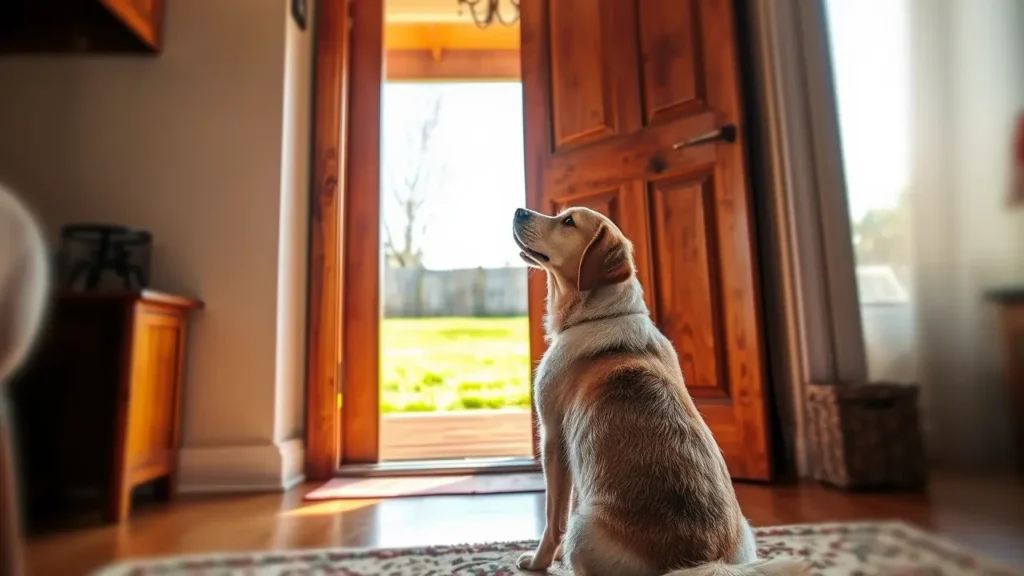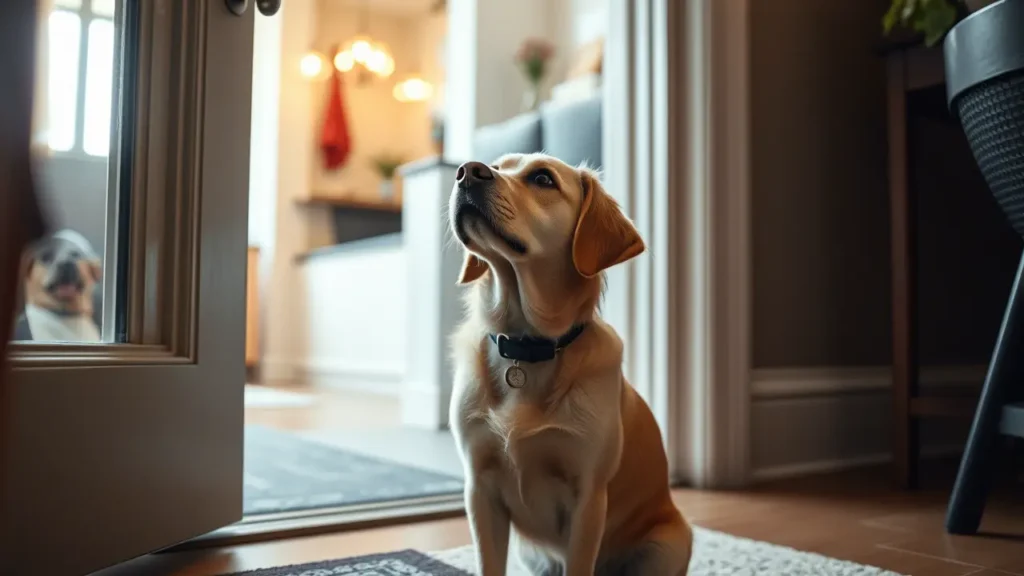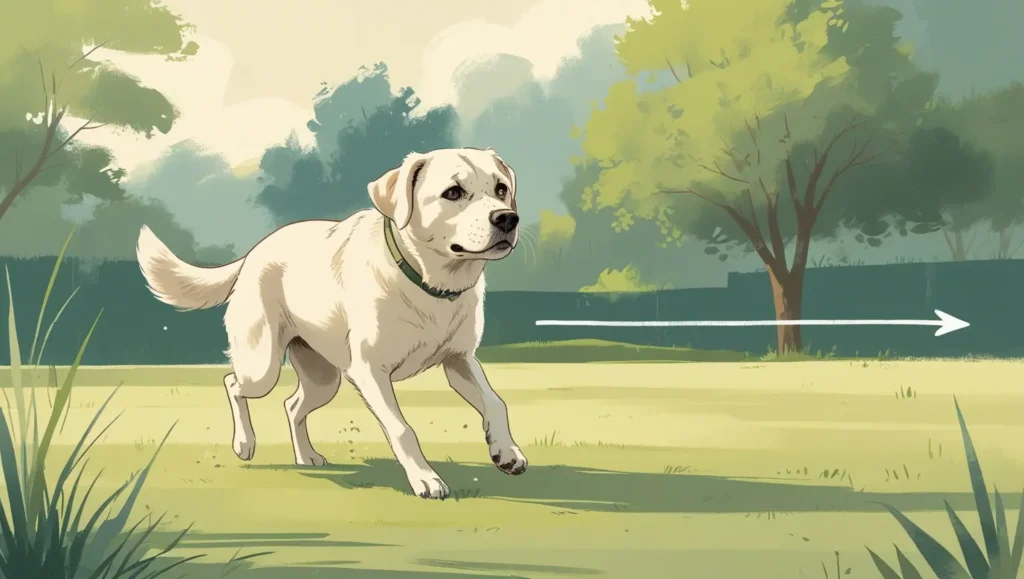Training your dog to wait at the door is a foundational skill that promotes safety, strengthens your bond, and instills good manners. This behavior requires your dog to pause and seek your permission before crossing a threshold. It’s a practical command that applies to everyday scenarios, from preventing chaotic exits to ensuring calm greetings with guests.
Benefits of Training Your Dog to Wait at the Door
The “wait” command is more than just a trick—it’s a life-enhancing tool that brings tangible advantages to both you and your dog. Here are the key benefits:
A dog that bolts out an open door risks getting lost, encountering aggressive animals, or being struck by a vehicle. Training your dog to wait ensures they remain under control, reducing these dangers.
Teaching “wait” reinforces your role as the leader in a positive, non-confrontational way. It helps your dog look to you for guidance, making it easier to manage them in high-energy situations.
Guests, delivery personnel, or neighbors won’t be greeted by a dog charging at them. This is especially important for vulnerable visitors, such as children or the elderly, who may feel intimidated or lose balance.
A dog that waits calmly at the door is better equipped to handle public spaces, such as vet offices or pet-friendly cafes, where impulse control is essential.
The “wait” command lays the groundwork for other impulse-control behaviors, such as waiting before exiting a crate, crossing a street, or eating their food. It’s a building block for advanced training.
A dog that waits eliminates the chaos of rushed exits or frantic scrambles to catch them, creating a more harmonious home environment.
Difficulties Without This Training
Failing to train your dog to wait at the door can lead to a range of problems that affect safety, relationships, and your dog’s overall behavior. Here’s what you might face:
Without the “wait” command, dogs may dart out of open doors, especially when excited by stimuli like squirrels or passersby. This increases the risk of accidents, injuries, or getting lost.
An untrained dog may jump on or overwhelm visitors, causing discomfort or even injury. For example, a large dog could knock over a toddler or scare someone unfamiliar with dogs.
Managing a dog that lunges toward the door every time it opens is exhausting. It can lead to stressful situations, such as wrestling with your dog while holding groceries or trying to answer the doorbell.
Dogs that repeatedly charge the door may develop related issues, like excessive barking, jumping, or territorial behavior, which are harder to correct over time.
Impulse control is a cornerstone of obedience. Without mastering “wait,” your dog may struggle with other commands that require patience, limiting their potential for more complex training.
A dog that barrels through doors can create awkward or unsafe situations in public, such as tripping someone at a park or disrupting a calm setting.
Step-by-Step Guide to Train Your Dog to Wait at the Door
Training your dog to wait at the door requires patience, consistency, and positive reinforcement. The following steps are designed to be progressive, building your dog’s understanding and confidence. Depending on your dog’s temperament and prior training, this process may take a few days to several weeks. Tailor the pace to your dog’s needs, and always end sessions on a positive note.

Step 1: Gather Supplies and Set Up
Choose small, high-value treats that your dog finds irresistible, such as bits of cooked chicken, freeze-dried liver, or soft training treats. Keep them easily accessible in a pouch or pocket.
For dogs that are easily excited or prone to lunging, a leash provides extra control during early sessions. Use a standard 6-foot leash, not a retractable one.
If you use clicker training, have your clicker ready to mark the exact moment your dog performs the desired behavior.
Start in a low-distraction setting, such as a hallway or room with a door that’s not frequently used, to help your dog focus.
If your dog has a short attention span, tire them out with a walk or play session before training to increase focus.
Step 2: Introduce the “Wait” Command
Begin inside your home with the door closed. Walk your dog toward the door, stopping 2-3 feet away. If using a leash, keep it loose to avoid tension.
Say “wait” in a clear, calm voice and pair it with a visual cue, such as holding your palm toward the dog (like a stop sign). Consistency with the cue is crucial. If your dog pauses, even for a second, immediately reward them with a treat and verbal praise (e.g., “Good wait!”). If using a clicker, click the moment they stop moving.
If your dog moves toward the door, gently guide them back to the starting position using the leash or your body, and repeat the “wait” command. Avoid scolding; simply reset and try again. Practice this step for several sessions until your dog consistently pauses when you say “wait.”
If your dog is a high-energy Labrador, they might initially try to pull toward the door. Reward the slightest hesitation, like a brief glance at you, to build the behavior.
Step 3: Open the Door Slightly
Once your dog reliably pauses with the door closed, introduce the challenge of an open door. Say “wait,” then slowly open the door a few inches. Watch your dog closely for any signs of movement.
If they stay in place, reward them with a treat and praise. If using a clicker, mark the moment they hold still. If they move forward, quickly close the door (gently, to avoid startling them) and guide them back to the starting position. Repeat until they remain still with the door slightly open. Gradually increase the duration they must wait (e.g., 2 seconds, then 5 seconds) before rewarding.
If your dog consistently lunges when the door opens, return to Step 2 and reinforce the “wait” command with the door closed. You may also need to increase the value of the treats to compete with the excitement of the open door.
Step 4: Increase the Challenge
Progress to opening the door wider, eventually all the way, while asking your dog to “wait.” Introduce a release cue, such as “okay,” “free,” or “go,” to signal when they can move through the door. For example, say “wait,” open the door, wait 3 seconds, then say “okay” and let them walk through. Reward them after they cross the threshold to reinforce the sequence.
Add distractions to mimic real-life scenarios. For instance, toss a toy outside, ring the doorbell, or have a family member walk by. Reward your dog for staying put despite the temptation.
Practice at different times of day and with varying levels of excitement (e.g., before a walk when your dog is eager).
If your dog struggles with distractions, start with mild ones and gradually increase intensity. Always set them up for success by adjusting the difficulty to their skill level.
Step 5: Practice in Real-Life Scenarios
Generalize the behavior by practicing at different doors, such as the back door, garage door, or car door. Each new context may require a brief return to earlier steps.
Incorporate real-world triggers, such as answering the door for a delivery or inviting a friend inside. Ask your dog to “wait” while you handle the interaction, then release them with the cue.
Practice in public settings if applicable, such as at a pet store or park gate, to ensure the behavior holds in diverse environments.
Involve family members or roommates to ensure everyone uses the same command and release cue, maintaining consistency.
If you’re training a small dog like a Terrier, they might be more reactive to doorbell sounds. Have a helper ring the bell while you reward your dog for staying calm during the “wait.”
Step 6: Fade Out Treats and Maintain the Behavior
Once your dog consistently waits at the door for 5-10 seconds, begin reducing treat rewards. Start by rewarding every other successful “wait,” then every third, and so on.
Replace treats with praise, a pat, or access to the outdoors (e.g., letting them walk through the door after the release cue) as a natural reward.
Continue using the “wait” command and release cue in daily life to keep the behavior sharp. For example, ask for a “wait” before letting them out for a potty break or into the car for a ride.
Periodically revisit training sessions with treats to reinforce the behavior, especially if your dog starts to regress.
Incorporate “wait” into your routine, like asking for it before opening the crate or serving food, to keep your dog’s impulse control strong.
Additional Tips for Success
Keep sessions short and fun. Train for 5-10 minutes, 2-3 times a day, to prevent boredom or frustration. End each session with a success, even if it’s a simple “wait” with the door closed.
Stay calm and positive. Dogs are sensitive to your emotions. Use a calm, upbeat tone to encourage cooperation and avoid frustration, which can confuse or stress your dog.
Be consistent across contexts. Ensure everyone in the household uses the same verbal and visual cues. Inconsistent commands can confuse your dog.
If your dog struggles, backtrack to an easier step. For example, if they break the “wait” when a guest arrives, practice with a closed door again. Adapt to your dog’s personality. High-energy breeds need more repetitions, while sensitive dogs respond better to gentle encouragement.
Once the behavior is solid, use access to exciting things as a reward for waiting, making the training relevant to your dog. If your dog is highly reactive or struggles despite consistent effort, consult a certified dog trainer or behaviorist for personalized guidance.
Training your dog to wait at the door is a powerful way to enhance safety. By following this expanded step-by-step guide, you’ll build a stronger bond and a more harmonious household. Start today, and enjoy the peace of mind that comes with a well-trained dog who waits patiently at the door.




